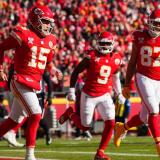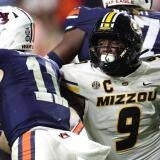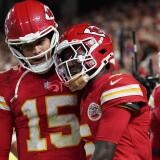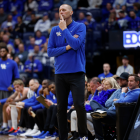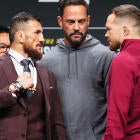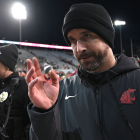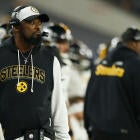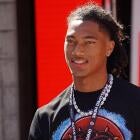Ramirez, Moore, Verlander among top 2016 AL bounceback candidates
A look at players in the American League who can bounce back from tough seasons ths

That precious time of the year is upon us again, when most every team’s fanbase is hopeful about the season, or about a prospect’s chances of beating the odds, or what have you. In short, hope springs eternal -- especially as spring training is nearing its end.
We’ve decided to join in on the fun by focusing on some veterans -- specifically those coming off bad or lost seasons. Below is a player per division (plus an honorable mention) who we think will enjoy a more fruitful 2016.
Hanley Ramirez, Boston Red Sox.
Ramirez’s first year in Boston was a mess. He didn’t take well to left field, but then he’s never been much of a defender; more jarring -- and concerning for the long term -- is how he failed to hit. Sure, Ramirez’s power production improved from 2014, yet that can be largely attributed to his change in venues -- moving from pitcher-friendly Dodgers Stadium to hitter-friendly Fenway Park. That extra thump didn’t matter much anyway, since his average and walk rate each tanked, with the latter checking in at roughly half his career norm entering the year.
So why is Ramirez on this list? Because of his track record. Prior to 2015, he’d been an above-average hitter in nine of his previous 10 full seasons. The old parlance states that hitters hit, and Ramirez has always been a hitter. Injuries have taken their cut from him throughout his career -- he’s fallen short of the 600-plate appearance mark in four of the last five years -- but it’s hard to imagine his decline being this steep and sudden. Ramirez, after all, just turned 32 in December, and is only two full seasons removed from earning MVP consideration.
Statistically, the argument for a Ramirez renaissance hinges on his batting average on balls in play. His .257 BABIP was 18 points below his previous career-low, and nearly 70 points shy of his career average heading into last season. Even accepting that Ramirez probably didn’t make as much loud contact in 2015 as he had in the past, there’s more than enough wiggle room for a bounceback. The one counterpoint worth highlighting is how his groundball rate was the highest it’s been since 2011 -- interestingly enough, the only other time he’s been a below-average hitter. Given Ramirez’s average-at-best foot speed and reputed disinclination toward hustling, hitting more balls in the air would probably be for the best heading forward.
With three years and $66 million remaining on Ramirez’s contract, the Red Sox would like something better to cling to than history-based hope. For now, that’ll have to do.
Honorable Mention: Matt Moore, Rays. Moore’s initial return from Tommy John surgery went poorly, as he was demoted to Triple-A following six starts in which he allowed 42 hits and 26 runs in 26 innings. He returned about a month later and still allowed more hits than usual, but nonetheless posted a 2.97 ERA and recorded 19 more strikeouts than walks in 36 innings. Moore’s fastball featured plenty of life already, and his velocity has improved this spring to the point where he’s sitting in the 93-95 mph range. Factor in how he’s coming off a rehab-free winter, and there’s sufficient reason to believe he could return to his 2013 form, when he made the All-Star team and earned Cy Young votes.
Justin Verlander, Detroit Tigers.
Okay, this one is probably cheating.
For all intents and purposes, Verlander’s impressive comeback happened last season. He was shelled in five first-half starts following his return from the disabled list, yielding 31 hits and 19 runs in 30 innings. The second half began poorly, too, as he allowed seven runs in 3 2/3 innings against the Orioles -- the shortest start of his season. After that? Woo wee, was Verlander ever nails: he tallied at least six innings in each of his 14 starts; he struck out 91 batters in 99 innings; he allowed less than a baserunner per inning; and he finished the year with his finest strikeout-to-walk ratio since 2012 -- the last time he earned serious Cy Young consideration.
The commonly accepted explanation for Verlander’s rebirth stemmed from a philosophical switch. In the simplest terms, he dared hitters to square up his fastball. That might not sound like a great approach from an aging pitcher whose velocity has slipped in recent years, but it worked -- in large part because Verlander’s heater features elite backspin, making it difficult for even the best hitters to get their bat heads on the same plane.
Verlander is about to enter his age-33 season and there’s significant mileage on his arm -- he ranks sixth in innings since his 2005 debut . . . and he threw all of 11 innings that year -- but there’s reason to think he can outdo last season’s overall numbers -- and that he just might make another All-Star Game or two.
Honorable Mention: Yan Gomes, Indians. Gomes entered last season viewed as an above-average backstop on both sides of the ball. Unfortunately, he sprained his knee in April and spent most of the year trying to get back on track. While he’s always employed a swing-happy approach, his 3.3 percent walk rate established a new career-low. That might not’ve mattered if Gomes was slugging like usual, but he wasn’t -- not until September, when he notched more than a third of his seasonal extra-base hits. It’s worth noting that Gomes’ numbers against southpaws were wretched (.208/.248/.297), and far, far worse than his career norms (including 2015: .285/.323/.465). Presuming those splits correct, and that Gomes’ knee doesn’t pester him heading forward, he could reclaim his position as one of the best catchers in the AL.
Similar to Moore, Perez underwent Tommy John surgery in 2014 and returned last summer to less-than-stellar results. He pitched fine from an ERA perspective, but his strikeout percentage was on par with the likes of Doug Fister and Alfredo Simon, two disappointing back-end types.
While the thinking here is that Perez will benefit from a normal winter, that’s not the only selling point. He’ll turn 25 next week -- a reminder that he debuted at a young 21 -- and showed some encouraging signs in 2015. He threw more strikes than previously -- important because location is considered the final thing to return -- and generated a new career-high percentage of groundballs while holding opponents to three home runs in nearly 80 innings pitched. Perez also saw his velocity improve as the year beat on, and continued to throw an excellent changeup.
The last tidbit is crucial to Perez’s growth. Despite that change of pace, he’s always pitched poorly against right-handed batters (in 2015, they hit .304/.352/.425 against him -- roughly equivalent to Christian Yelich’s season-long numbers). Frankly, it’s hard not to ponder whether Perez would be better served to throw his changeup more often. Comparing pitch usage across pitchers is always misleading -- everyone’s optimal strategy differs -- but whereas Perez has pulled the string on less than 20 percent of his pitches against righties in two of the past three seasons, Cole Hamels’ change has accounted for at least a quarter of his pitches versus righties in each big-league season except one -- 2010, when he threw it 24 percent of the time.
Whether Perez makes the necessary adjustments to become more than a mid-rotation starter is anyone’s guess; he certainly doesn’t have to in order to justify the Rangers’ decision to hand him a four-year, $12.5 million extension following the 2013 season -- and given how many injuries the Rangers have had in recent years, they’d probably settle for him making 25-plus league-average starts. Nonetheless, we’re willing to label Perez a nifty comeback candidate whose breakout chances remain considerable.
Honorable Mention: Leonys Martin, Mariners. Martin had a brutal 2015: he hit .219/.264/.312; lost his starting job to a Rule 5 pick; got demoted to the minors in August; and later left the Rangers after being told he wasn’t on the postseason roster. Luckily, he gets a new slate in Seattle, where he ought to prove to be a good pickup. He’s a high-grade defensive center fielder with a strong arm and well-above-average wheels that play as well on the basepaths dirt (81 steals at a 76 percent clip over the last three seasons) as they do on the outfield lawn. Martin has never been a great hitter -- he lacks the approach or the pop to bat higher than the bottom-third of an order -- and his platoon splits suggest he should sit against lefties. Still, he just turned 28 and his secondary skills should make him a key contributor to the M’s most-days lineup.



